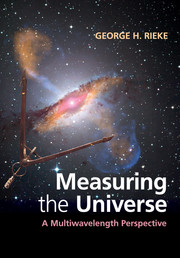Book contents
- Frontmatter
- Contents
- Preface
- 1 Radiometry, optics, statistics
- 2 Telescopes
- 3 Detectors for the ultraviolet through the infrared
- 4 Optical and infrared imaging; astrometry
- 5 Photometry and polarimetry
- 6 Spectroscopy
- 7 Adaptive optics and high-contrast imaging
- 8 Submillimeter and radio astronomy
- 9 Interferometry and aperture synthesis
- 10 X- and gamma-ray astronomy
- 11 Epilogue: cosmic rays, neutrinos, gravitational waves
- Appendix A Useful constants
- Appendix B Common Fourier transforms and relations
- References
- Index
- References
5 - Photometry and polarimetry
Published online by Cambridge University Press: 05 November 2012
- Frontmatter
- Contents
- Preface
- 1 Radiometry, optics, statistics
- 2 Telescopes
- 3 Detectors for the ultraviolet through the infrared
- 4 Optical and infrared imaging; astrometry
- 5 Photometry and polarimetry
- 6 Spectroscopy
- 7 Adaptive optics and high-contrast imaging
- 8 Submillimeter and radio astronomy
- 9 Interferometry and aperture synthesis
- 10 X- and gamma-ray astronomy
- 11 Epilogue: cosmic rays, neutrinos, gravitational waves
- Appendix A Useful constants
- Appendix B Common Fourier transforms and relations
- References
- Index
- References
Summary
Introduction
Most of what we know about astronomical sources comes from measuring their spectral energy distributions (SEDs) or from taking spectra. We can distinguish the two approaches in terms of the spectral resolution, defined as R = λ/Δλ, where λ is the wavelength of observation and Δλ is the range of wavelengths around λ that are combined into a single flux measurement. Photometry refers to the procedures for measuring or comparing SEDs and is typically obtained at R ~ 2–10. It is discussed in this chapter, while spectroscopy (with R ≥ 10) is described in the following one.
In the optical and near-infrared, nearly all the initial photometry was obtained on stars, whose SEDs are a related family of modified blackbodies with relative characteristics determined primarily by a small set of free parameters (e.g., temperature, reddening, composition, surface gravity). Useful comparisons among stars can be obtained relatively easily by defining a photometric system, which is a set of response bands for the [(telescope)-(instrument optics)-(defining optical filter)-(detector)] combination. Comparisons of measurements of stars with such a system, commonly called colors, can reveal their relative temperatures, reddening, and other parameters. Such comparisons are facilitated by defining a set of reference stars whose colors have been determined accurately and that can be used as transfer standards from one unknown star to another. This process is called classical stellar photometry. It does not require that the measurements be converted into physical units; all the results are relative to measurements of a network of stars. Instead, its validity depends on the stability of the photometric system and the accuracy with which it can be reproduced by other astronomers carrying out comparable measurements.
- Type
- Chapter
- Information
- Measuring the UniverseA Multiwavelength Perspective, pp. 120 - 153Publisher: Cambridge University PressPrint publication year: 2012



